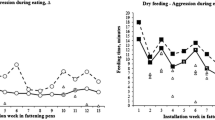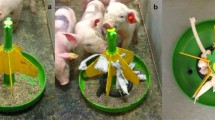Abstract
Housing nursery pigs according to body weight is an observed common practice in production systems and, supposedly, improves growth performance and reduces body weight (BW) variation. This 42-day study evaluated the effects of housing nursery pigs according to BW on performance, onset of feed intake, and aggressive behavior. A total of 504 pigs were ranked by BW at weaning and categorized into three groups of 168 pigs each: light, medium, and heavy. Pigs were randomly distributed to unsorted pens (Unsorted) containing 6 pigs of each weight group and sorted pens with 18 pigs from just one group per pen (Sorted). From weaning to day 3, pigs were fed a diet containing 1% iron oxide dye and rectal swabs presenting red coloration were evaluated to assess feed intake onset. Eight pens were video recorded to evaluate aggressive behavior. Sorted-Heavy pigs delayed the onset of feed intake (P ≤ 0.011) and presented more aggressive behaviors than Sorted-Light and Sorted-Medium pigs (P ≤ 0.036). In Unsorted, onset of feed intake showed no differences between weight categories. Also, no differences were observed for aggressive behavior between Sorted and Unsorted. Final BW showed no differences between Sorted and Unsorted pigs. The within-pen weight coefficient variation (CV) was slightly different (P = 0.042) between Sorted and Unsorted pigs (13.3 and 15.6%, respectively), at the end of the study. Thus, sorting nursery pigs by BW did not improve growth performance and also, induce a lag of post-weaning feed intake onset and increased fights in Heavy pigs.

Similar content being viewed by others
References
Brouns, F., Edwards, S.A., 1994. Social rank and feeding behavior of group housed sows fed competitively or ad libitum. Applied Animal Behaviour Science, 39, 225–235
Bruininx, E.M.A.M., Van Der Peet-Schwering, C.M.C., Schrama, J.W., Vereijken, P.F.G., Vesseur, P.C., Everts, H., Den Hartog, L.A., Beynen, A.C., 2001. Individually measured feed intake characteristics and growth performance of group-housed weanling pigs: effects of sex, initial body weight, and body weight distribution within groups. Journal of Animal Science, 79, 301–308
Brumm, M.C., Ellis, M., Johnston, L.J., Rozeboom, D.W., Zimmerman D.R., NCR–89 Committee on swine management, 2002. Effect of removal and remixing of lightweight pigs on performance to slaughter. Journal of Animal Science, 80, 1166–1172
Cámara, L., Berrocoso, J.D., Fuentetaja, A., López-Bote, C.J, De Blas, C., Mateos, G.G., 2016. Regrouping of pigs by body weight at weaning does not affect growth performance, carcass quality or uniformity at slaughter of heavy weight pigs. Animal Science Journal, 87, 134–142
D’eath, R.B., 2002. Individual aggressiveness measured in a resident intruder test predicts the persistence of aggressive behavior and weight gain of young pigs after mixing. Applied Animal Behaviour Science, 77, 267–283
Langbein, J., Puppe, B., 2004. Analysing dominance relationships by sociometric methods–a plea for a more standardised and precise approach in farm animals. Applied Animal Behaviour Science, 87, 293–315
Laskoski, F., Faccin, J.E.G., Vier, C.M., Gonçalves, M.A.D., Orlando, U.A.D., Kummer, R., Mellagi, A.P.G., Bernardi, M.L., Wentz. I., Bortolozzo, F.P. 2019. Effects of pigs per feeder hole and group size on feed intake onset, growth performance, and ear and tail lesions in nursery pigs with consistent space allowance. Journal of Swine Health and Production, 27, 12–18.
Madec, F., Le Dividich, J., Pluske, J.R., Verstegen, M.W.A, 2003. Environmental requirements and housing of the weaned pig. In: J.R. Pluske, J. Le Dividich, M.W.A. Verstegen (eds), Weaning the pig: concepts and consequences, Wagening, 2003, (Wagening Academic Publishers, Wagening, Netherlands), 337–355.
O’Quinn, P.R., Dritz, S.S., Goodband, R.D., Tokach, M.D., Swanson J.C., Nelseen, J.L., Misser, R.E., 2001. Sorting growing-finishing pigs by weight fails to improve growth performance or weight variation. Journal of Swine Health and Production, 9, 11–16
Patience, J.F., Engele, K., Beaulieu, A.D., Gonyou, H.W., Zijlstra, R.T., 2004.Variation: costs and consequences. In: Proceedings of the 15rd Banff Pork Seminar, Saskatoon, 2004, (Advances in Pork Production, Canada, Volume 15), 257–266
Puppe, B., 1998. Effects of familiarity and relatedness on agonistic pair relationships in newly mixed domestic pigs. Applied Animal Behaviour Science, 58, 233–239
Rushen, J.A., 1987. Difference in weight reduces fighting when unacquainted newly weaned pigs first meet. Canadian Journal of Animal Science, 67, 951–960
Sulabo, R.C., Jacela, J.Y., Tokach, M.D., Dritz, S.S., Goodband, R.D., Derouchey, J.M., Nelssen, J.L., 2010. Effects of lactation feed intake and creep feeding on sow and piglet performance. Journal of Animal Science, 88, 3145–3153
Stukenborg, A., Traulsen, I., Puppe, B., Presuhn, U., Krieter, J., 2011. Agonistic behaviour after mixing in pigs under commercial farm conditions. Applied Animal Behaviour Science, 129, 28–35
Williams, I.H., 2003. Growth of the weaned pig. In: J.R. Pluske, J. Le Dividich, M.W.A. Verstegen (eds), Weaning the pig: concepts and consequences, Wagening, 2003, (Wagening Academic Publishers, Wagening, Netherlands), 17–36
Wolter, B.F., Ellis, M., 2001. The effects of weaning weight and rate of growth immediately after weaning on subsequent pig growth performance and carcass characteristics. Canadian Journal of Animal Science, 81, 361–369
Wolter, B.F., Ellis, M., Corrigan, B.P., DeDecker, J.M., Curtis, S.E., Parr, E.N., Webel, D.M., 2003. Impact of early postweaning growth rate as affected by diet complexity and space allocation on subsequent growth performance of pigs in a wean-to-finish production system. Journal of Animal Science, 81(2), 353–359
Author information
Authors and Affiliations
Corresponding author
Ethics declarations
Conflict of interest
The authors declare that they have no conflict of interest.
Statement of animal rights
The Institutional Animal Care and Use Committee of the Universidade Federal do Rio Grande do Sul approved the protocol used in this experiment according to the procedure PROPESQ-UFRGS 30545.
Additional information
Publisher’s note
Springer Nature remains neutral with regard to jurisdictional claims in published maps and institutional affiliations.
Rights and permissions
About this article
Cite this article
Faccin, J.E.G., Laskoski, F., Quirino, M. et al. Impact of housing nursery pigs according to body weight on the onset of feed intake, aggressive behavior, and growth performance. Trop Anim Health Prod 52, 1073–1079 (2020). https://doi.org/10.1007/s11250-019-02096-6
Received:
Accepted:
Published:
Issue Date:
DOI: https://doi.org/10.1007/s11250-019-02096-6




